

Nazi Party (political party, Germany. Nazi propaganda. The propaganda used by the Nazi Party in the years leading up to and during Adolf Hitler's leadership of Germany (1933–1945) was a crucial instrument for acquiring and maintaining power, and for the implementation of Nazi policies, including the pursuit of total war and the extermination of millions of people in the Holocaust.
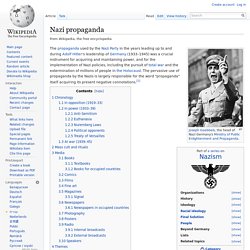
The pervasive use of propaganda by the Nazis is largely responsible for the word "propaganda" itself acquiring its present negative connotations.[1] Chronology[edit] In opposition (1919–33)[edit] Nazi leader Adolf Hitler devoted three chapters of his 1925/26 book Mein Kampf, itself a propaganda tool, to the study and practice of propaganda.[2] He claimed to have learnt the value of propaganda as a World War I infantryman exposed to very effective British and ineffectual German propaganda.[3] The argument that Germany lost the war largely because of British propaganda efforts, expounded at length in Mein Kampf, reflected then-common German nationalist claims.
Holocaust Timeline: The Rise of the Nazi Party. While in prison, Hitler wrote volume one of Mein Kampf (My Struggle) , which was published in 1925.
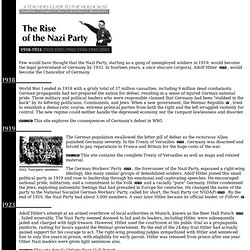
This work detailed Hitler's radical ideas of German nationalism, antisemitism, and anti-Bolshevism. Linked with Social Darwinism, the human struggle that said that might makes right, Hitler's book became the ideological base for the Nazi Party's racist beliefs and murderous practices. Holocaust Museum Houston. Anne Frank Museum Amsterdam - the official Anne Frank House website. Preventing Genocide - What is Genocide? The term “genocide” did not exist prior to 1944.
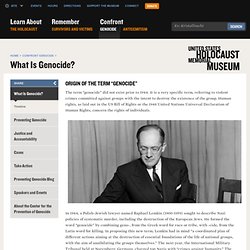
Genocides in history. The preamble to the CPPCG states that "genocide is a crime under international law, contrary to the spirit and aims of the United Nations and condemned by the civilized world" and that "at all periods of history genocide has inflicted great losses on humanity".[1] Determining what historical events constitute a genocide and which are merely criminal or inhuman behavior is not a clear-cut matter.
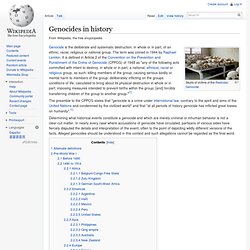
In nearly every case where accusations of genocide have circulated, partisans of various sides have fiercely disputed the details and interpretation of the event, often to the point of depicting wildly different versions of the facts. Alleged genocides should be understood in this context and such allegations cannot be regarded as the final word. Alternate definitions[edit] Legally, genocide is defined as any conflict that the International Criminal Court has so designated.
M. According to R. Pre-World War I[edit] Before 1490[edit] 1490 to 1914[edit] Were American Indians the Victims of Genocide? September 2004 tags: American Indians by Guenter Lewy Guenter Lewy, who for many years taught political science at the University of Massachusetts, has been a contributor to Commentary since 1964.
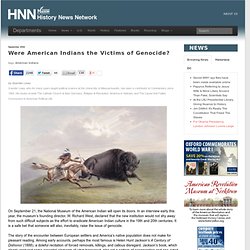
GENOCIDE - CAMBODIA. Cambodia is a country in South East Asia, less than half the size of California and twice the size of Scotland.

Once it was the centre of the ancient kingdom of the Khmer, and its capital was Angkor, famous for its 12th century temples. The present day capital is Phnom Penh. In 1953 Cambodia gained independence after nearly 100 years of French rule. In the 1960s the population was over 7m, almost all Buddhists, under the rule of a monarch, Prince Sihanouk.
In 1970 Prince Sihanouk was deposed in a military coup. Cambodia was also caught up in another country's war. Under Prince Sihanouk, Cambodia had preserved neutrality during the Vietnamese civil war by giving a little to both sides: Vietnamese communists were allowed to use a Cambodian port to ship in supplies, the USA were allowed to bomb - secretly and illegitimately - Viet Cong hideouts in Cambodia. Armenian Genocide. The Armenian Genocide[7] (Armenian: Հայոց Ցեղասպանություն Hayots Tseghaspanutyun),[8] also known as the Armenian Holocaust, the Armenian Massacres and, traditionally by Armenians, as Medz Yeghern (Armenian: Մեծ Եղեռն, "Great Crime"),[9] was the Ottoman government's systematic extermination of its minority Armenian subjects from their historic homeland within the territory constituting the present-day Republic of Turkey.
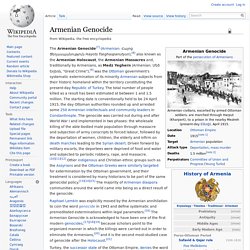
The total number of people killed as a result has been estimated at between 1 and 1.5 million. The starting date is conventionally held to be 24 April 1915, the day Ottoman authorities rounded up and arrested some 250 Armenian intellectuals and community leaders in Constantinople. Turkey, the successor state of the Ottoman Empire, denies the word genocide is an accurate term for the mass killings of Armenians that began under Ottoman rule in 1915.[22] It has in recent years been faced with repeated calls to recognize them as genocide. Background Prelude to genocide. Genocide in Darfur.
Rwanda: The Wake of a Genocide. Home - Simon Wiesenthal Center Multimedia Learning Center. United States Holocaust Memorial Museum. Frequently Asked Questions. 1.
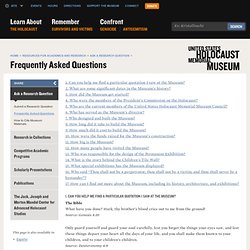
Can you help me find a particular quotation I saw at the Museum? 2. What are some significant dates in the Museum’s history? 3. How did the Museum get started? 1. The Bible What have you done? Only guard yourself and guard your soul carefully, lest you forget the things your eyes saw, and lest these things depart your heart all the days of your life, and you shall make them known to your children, and to your children’s children.Source: Deuteronomy 4:9 I call heaven and earth to witness this day: I have put before you life and death, blessing and curse. You are my witnesses.Source: Isaiah 43:10 George H. Jimmy Carter Out of our memory...of the Holocaust we must forge an unshakable oath with all civilized people that never again will the world stand silent, never again will the world...fail to act in time to prevent this terrible crime of genocide....we must harness the outrage of our own memories to stamp out oppression wherever it exists.
William J. General Dwight D. Harry S. 2. Nazi Camps. INTRODUCTION Between 1933 and 1945, Nazi Germany established about 20,000 camps to imprison its many millions of victims.
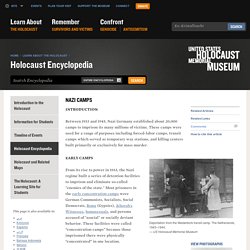
These camps were used for a range of purposes including forced-labor camps, transit camps which served as temporary way stations, and killing centers built primarily or exclusively for mass murder. EARLY CAMPS From its rise to power in 1933, the Nazi regime built a series of detention facilities to imprison and eliminate so-called "enemies of the state. " Most prisoners in the early concentration camps were German Communists, Socialists, Social Democrats, Roma (Gypsies), Jehovah's Witnesses, homosexuals, and persons accused of "asocial" or socially deviant behavior.
These facilities were called “concentration camps” because those imprisoned there were physically “concentrated” in one location. Holocaust Timeline: The Camps. In January 1942, SS official Reinhard Heydrich held a meeting of Nazi government officials to present the Final Solution.
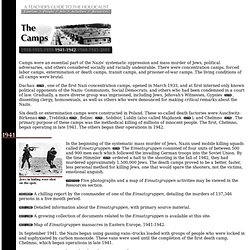
At this meeting, known as the Wannsee Conference. United States Holocaust Memorial Museum: Propaganda Exhibit. Explore the Nazis' sophisticated propaganda campaigns and their legacy. Features What Is Propaganda? Today, the word sounds ominous, conjuring up images of falsehood and manipulation, brainwashing and servility. It stands as the antithesis of objectivity, rationality, and truthfulness. But what is propaganda? Incitement to Genocide When is violent language a crime? Poll and Online Forum Can you create a democratic system while limiting a core democratic principle like freedom of expression?